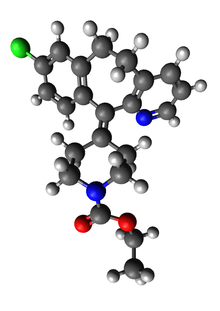
Back لوراتادين Arabic لوراتادین AZB লোরাটাডিন Bengali/Bangla Loratadin BS Loratadina Catalan Loratadin Welsh Loratadin Danish Loratadin German Λοραταδίνη Greek Loratadina Spanish
 | |
 | |
| Clinical data | |
|---|---|
| Trade names | Claritin, Claratyne, Clarityn, others |
| AHFS/Drugs.com | Monograph |
| MedlinePlus | a697038 |
| License data |
|
| Pregnancy category |
|
| Routes of administration | By mouth |
| Drug class | Second-generation antihistamine |
| ATC code | |
| Legal status | |
| Legal status | |
| Pharmacokinetic data | |
| Bioavailability | almost 100% |
| Protein binding | 97–99% |
| Metabolism | Liver (CYP2D6- and 3A4-mediated) |
| Elimination half-life | 8 hours, active metabolite desloratadine 27 hours |
| Excretion | 40% as conjugated metabolites into urine Similar amount into the feces |
| Identifiers | |
| |
| CAS Number | |
| PubChem CID | |
| IUPHAR/BPS | |
| DrugBank | |
| ChemSpider | |
| UNII | |
| KEGG | |
| ChEBI | |
| ChEMBL | |
| CompTox Dashboard (EPA) | |
| ECHA InfoCard | 100.120.122 |
| Chemical and physical data | |
| Formula | C22H23ClN2O2 |
| Molar mass | 382.89 g·mol−1 |
| 3D model (JSmol) | |
| |
| |
| | |
Loratadine, sold under the brand name Claritin among others, is a medication used to treat allergies.[5] This includes allergic rhinitis (hay fever) and hives.[5] It is also available in drug combinations such as loratadine/pseudoephedrine, in which it is combined with pseudoephedrine, a nasal decongestant.[5] It is taken orally.[5]
Common side effects include sleepiness, dry mouth, and headache.[5] Serious side effects are rare and include allergic reactions, seizures, and liver problems.[6] Use during pregnancy appears to be safe but has not been well studied.[7] It is not recommended in children less than two years old.[6] It is in the second-generation antihistamine family of medication.[5]
Loratadine was patented in 1980 and came to market in 1988.[8] It is on the World Health Organization's List of Essential Medicines.[9] Loratadine is available as a generic medication.[5][10] In the United States, it is available over the counter.[5] In 2021, it was the 67th most commonly prescribed medication in the United States, with more than 9 million prescriptions.[11][12]
- ^ "Loratadine Use During Pregnancy". Drugs.com. 10 February 2020. Retrieved 10 April 2020.
- ^ "FDA-sourced list of all drugs with black box warnings (Use Download Full Results and View Query links.)". nctr-crs.fda.gov. FDA. Retrieved 22 October 2023.
- ^ "Claritin Allergy Product information". Health Canada. 25 April 2012. Retrieved 7 June 2022.
- ^ "Clarityn Allergy 10mg Tablets (P & GSL) - Patient Information Leaflet (PIL)". (emc). 30 August 2019. Archived from the original on 10 April 2020. Retrieved 10 April 2020.
- ^ a b c d e f g h "Loratadine". The American Society of Health-System Pharmacists. Archived from the original on 21 December 2016. Retrieved 8 December 2016.
- ^ a b "Clarityn Allergy 10mg Tablets (P) - Summary of Product Characteristics (SmPC) - (eMC)". www.medicines.org.uk. 7 October 2015. Archived from the original on 20 December 2016. Retrieved 13 December 2016.
- ^ "Loratadine Use During Pregnancy". www.drugs.com. Archived from the original on 21 December 2016. Retrieved 13 December 2016.
- ^ Fischer J, Ganellin CR (2006). Analogue-based Drug Discovery. John Wiley & Sons. p. 549. ISBN 9783527607495.
- ^ World Health Organization (2019). World Health Organization model list of essential medicines: 21st list 2019. Geneva: World Health Organization. hdl:10665/325771. WHO/MVP/EMP/IAU/2019.06. License: CC BY-NC-SA 3.0 IGO.
- ^ "Competitive Generic Therapy Approvals". U.S. Food and Drug Administration (FDA). 3 March 2023. Retrieved 6 March 2023.
- ^ "The Top 300 of 2021". ClinCalc. Retrieved 14 January 2024.
- ^ "Loratadine - Drug Usage Statistics". ClinCalc. Retrieved 14 January 2024.
© MMXXIII Rich X Search. We shall prevail. All rights reserved. Rich X Search